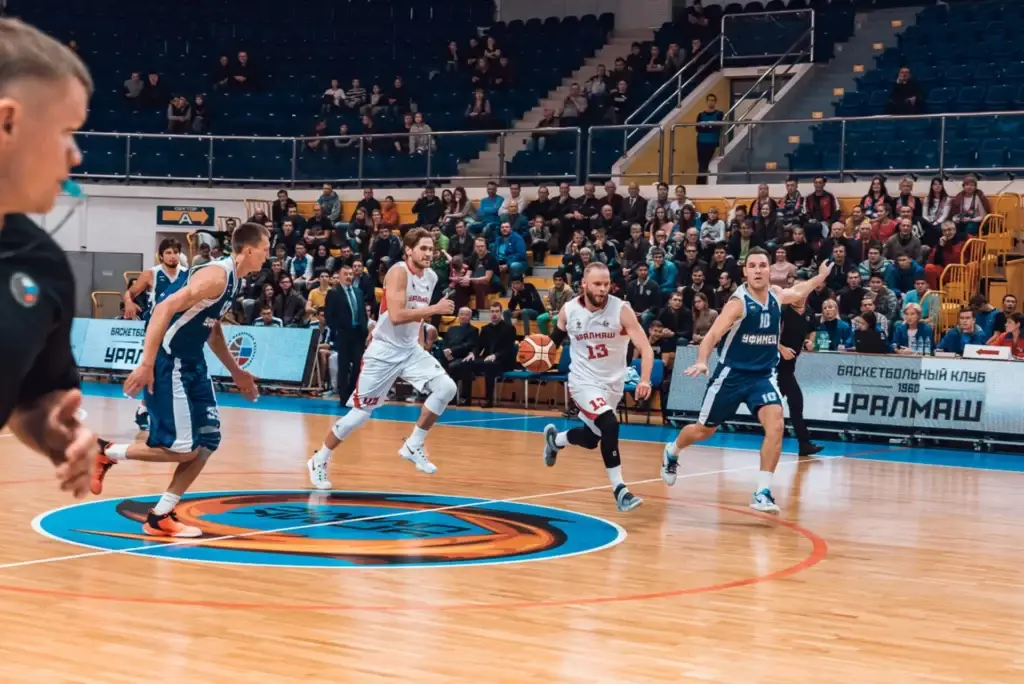A basketball drama in four acts, every second is filled with tension and passion. But how long does a basketball game really last? Time is not just a number here, it is a combination of strategy, unexpected pauses and exciting moments.
How the length of a basketball game was determined
It all started in 1891, when James Naismith, a teacher from Massachusetts, proposed a game that would keep his students engaged in the winter. There were no games in the traditional sense – the participants simply tossed the ball over fruit baskets until they got tired. There was no standard time, and the duration depended on the players’ endurance level and the school schedule.

Over time, as the popularity of the game began to rapidly increase, the need for strict time frames came to be understood. In the early 20th century, basketball took over the United States and became a real national passion. In 1946, when the Basketball Association of America (the predecessor of the NBA) was founded, periods were officially introduced to make the process more dynamic.
Initially, games consisted of two 20-minute halves, but then the model was changed to four quarters, each 12 minutes long. This innovation was aimed at giving coaches more opportunities to adjust tactics and provide athletes with more breaks to recuperate. In European leagues, the duration of one quarter is 10 minutes, which emphasizes the difference between the American style, more focused on individual achievements, and the European style, where the main role is given to teamwork.
How many quarters are there in a basketball game and how does this affect the rhythm of the game?
As we have already said, a modern basketball game is divided into four quarters, and this decision is the result of a long search for the ideal balance between spectacle and tactics. Dividing the game in this way allows coaches to fine-tune the situation on the field. Each quarter is like a separate chapter of a book, where absolutely anything can happen: from complete dominance of one team to a dramatic turning point that turns the course of the match 180 degrees.
It is interesting to note that this approach makes basketball different from other popular sports. For example, in football or hockey, time flows continuously, but in basketball it stops at every foul, timeout, which adds an additional element of tension. As a result, every moment can be decisive, and any second can change the course of events.
How Time is Calculated in Basketball: The Art of Managing Minutes
 At first glance, everything is quite simple: four quarters, each 12 or 10 minutes long, depending on the league. But the reality is much more complicated. Time in basketball, how long a game lasts, is a flexible tool that can be managed depending on the situation on the court.
At first glance, everything is quite simple: four quarters, each 12 or 10 minutes long, depending on the league. But the reality is much more complicated. Time in basketball, how long a game lasts, is a flexible tool that can be managed depending on the situation on the court.
Each game consists not only of official game time, but also of many pauses, including timeouts, foul stops, video replays and other situations. For example, in the NBA, coaches are allowed to take seven timeouts per game, and each of them can last up to 100 seconds. These pauses are often used for strategic purposes: when you need to slow down the opponent’s pace, give instructions to team members or just give leaders a break.
A striking example of the impact of time management on the outcome of a game can be seen in the 2013 NBA Finals between the Miami Heat and the San Antonio Spurs. Heat coach Erik Spoelstra used the last timeouts in such a way as to preserve the strength of key players and organize the final throws. This is what allowed Ray Allen to make the famous three-point shot that led the team to the championship.
Time here is not just a countdown of seconds, but a real art that only experienced coaches and athletes can master.
Breaks and overtime: moments of respite and dramatic endings
Each match includes several breaks: short pauses between quarters and longer breaks in the middle of the match. These minutes are the time when coaches can offer a fresh look at what is happening, change tactics and motivate the team.
In addition, the NBA and other professional leagues have timeouts, which are used to adjust the strategy or disrupt the attacking impulse of the opponent. Timeouts are an indispensable tool for coaches, who, like conductors, tune their team to the right rhythm and actions.
Overtime in Basketball: When a Tie Isn’t Enough
When the score is tied at the end of a quarter, the most interesting part begins — overtime in basketball, no matter where: in the NBA, Euroleague, college basketball, or amateur league. Overtime adds another 5 minutes to the total duration, and each of them is like a separate mini-final.
The rules of overtime are similar, and it is these moments that test the physical and mental readiness of athletes. It is one thing to play confidently for all four quarters, and quite another to cope with emotional stress and fatigue, when every mistake can decide the fate of the match.
For example, overtime in the 2016 Euroleague final between Fenerbahce and CSKA became a classic basketball drama, where the Muscovites were able to hold on to the advantage only in the final seconds, showing incredible endurance and skill.
How long does a basketball game last for women and men
Overtime in basketball for women and men differs not so much in the rules, but in the emotional component and tactical approaches. Men’s teams often focus on physical training and strength, which makes overtime a real battle of endurance.
Women’s teams, on the contrary, pay more attention to teamwork and technique, which adds spectacle and intellectual tension to each match. Time is used more rationally, and overtime here turns into chess on the court, where every combination is thought out to the smallest detail.

So how long does a basketball game last?
 The question cannot be answered unequivocally. How long a basketball game lasts: officially, four quarters of 10 or 12 minutes. But in reality, each one is a chain of emotions, tactics, strategies and coincidences stretching far beyond the numbers on the scoreboard.
The question cannot be answered unequivocally. How long a basketball game lasts: officially, four quarters of 10 or 12 minutes. But in reality, each one is a chain of emotions, tactics, strategies and coincidences stretching far beyond the numbers on the scoreboard.
 en
en  de
de  ar
ar  es
es  hi
hi  fr
fr  nl
nl  it
it  pt
pt  el
el 









